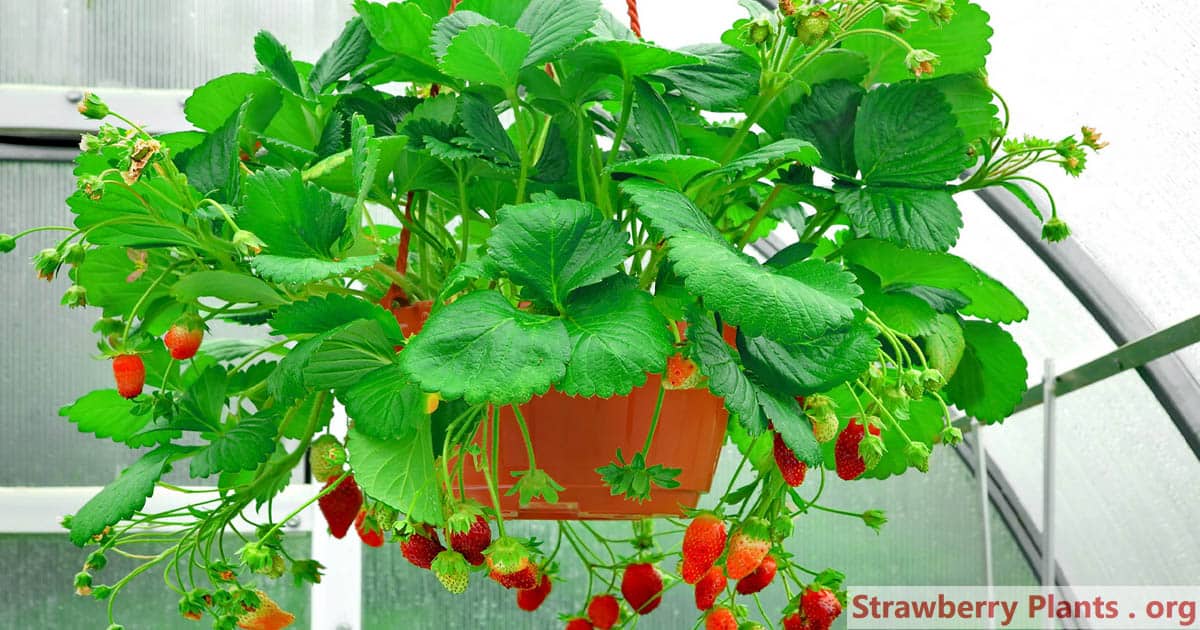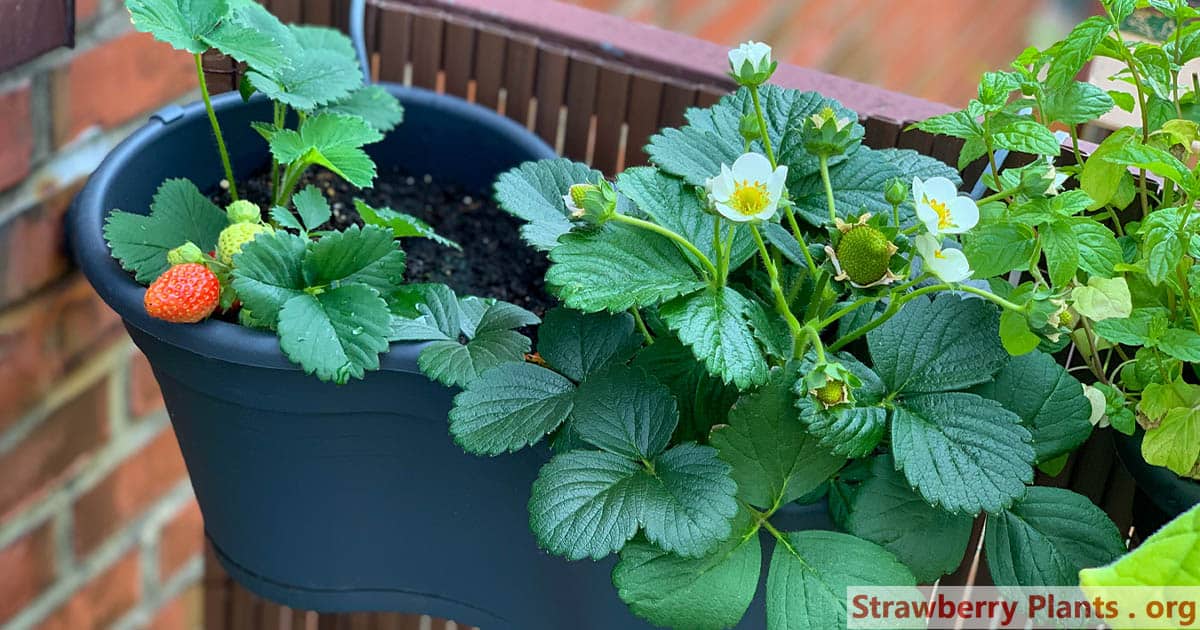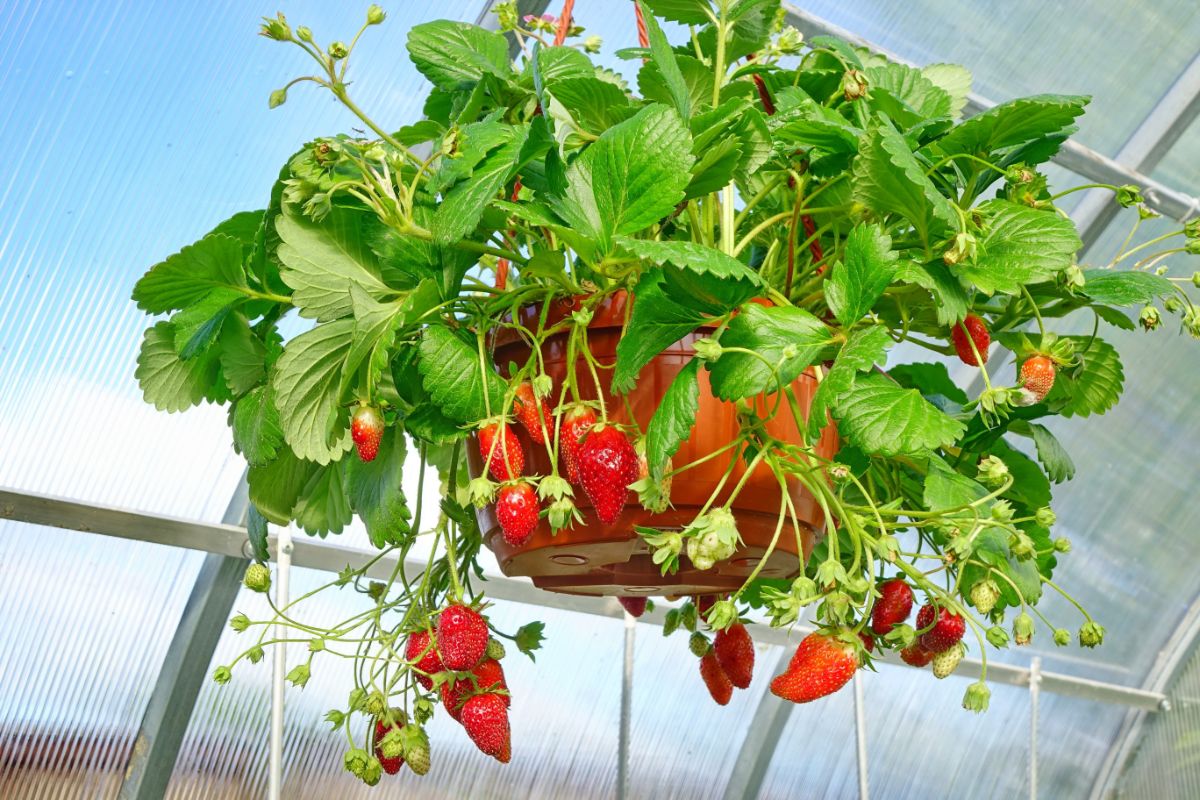Strawberries are one of the most popular fruits in North America, and in Europe, Australia, New Zealand, and much of the rest of the world. But most people have trouble growing them in beds.
It’s hard to get the soil right for a strawberry bed. A rainy spell or a single downpour can drown your strawberries, and humid, windless weather can bring on mold.
Strawberries growing at ground level are an easy target for insects and hungry wildlife—and you will spend a lot of time bent over even if you raise your strawberry plants in raised beds.
Growing strawberries in hanging baskets have many advantages. You can hang your baskets at the height you find optimally comfortable. You can move your strawberry baskets indoors to protect them from stormy weather and frosts. You will never have to worry about your strawberries standing in water, and you place them out of reach of many of the insects that carry disease or do leaf damage. But your strawberries will still be on the flight path of the bees that help them set fully formed, rounded fruit.

Many people love strawberries but don’t have land to till. For them, growing strawberries in hanging baskets take advantage of space on porches and patios and in tiny yards.
Jump to:
Recommended Planters and Supplies
[amazon box=”B00IXFEY7E,B08BCDN5BX,B08ZML7VMB,B007TFTXAC” grid=”2″]
What You Need to Know About Strawberry Plants
There are a few things you need to know about strawberry plants to grow them successfully in hanging baskets.
- Strawberry plants love the sun. Planting your strawberries in a basket you hang in a tree just won’t do. Strawberry plants need six to eight hours of full sun every day, preferably more. Strawberry plants that don’t get at least six hours of sun every day may not set fruit at all, or they may produce berries that are small, watery, and tart.
- Strawberry plants love good drainage. They love good drainage so much that they don’t have to be grown in soil. In fact, sometimes it is better if they aren’t. Soil contains fungi that get splashed up on your strawberry plants when it rains.
- Strawberry plants grown in the ground can be plagued by pests. Soil can harbor grubs and beetles that greedily devour the crowns of strawberry plants before they ever get a chance to put out runners. Soil-less hanging baskets, which we will describe a little later, avoid all of these problems, but require some extra planning.
- Strawberry plants love good air circulation. Crowded strawberry plants on the ground create pockets of moist air that isn’t stirred up by the wind. When there is prolonged cool and rainy weather, these little pockets in your strawberry bed encourage the growth of a fuzzy gray mold that can ruin your crop. When you plant your strawberries in hanging baskets and give them adequate water and fertilizer, they will put on dense foliage but there won’t be any pockets of still air in which fungus can grow.
The facts about strawberry plants all point to hanging baskets as a great way for home gardeners to grow them. Now let’s take a step-by-step look at how to grow your strawberries plants in hanging baskets.

Four Easy Steps for Getting Strawberries Started in Hanging Baskets
It’s not hard to get a good crop from strawberry plants grown in hanging baskets, but these four steps are essential.
- First, make sure that your hanging basket has drainage holes. Strawberries can’t grow roots in waterlogged soil. They can only be grown in containers that have drainage holes. If you are concerned about drainage from your hanging baskets staining your deck or porch, find an attractive drip plate to place underneath or attached to the hanging basket.
- Secondly, spend some time giving your strawberries a good growing medium. Dirt from your backyard is never a good idea. Instead, use a mixture of peat (provides acidity and releases water slowly), coconut fiber (provides just enough air circulation in the basket), and compost (rich in nutrients). Use about one-third of each.
- Next, make sure you are planting your strawberries in an appropriately sized container. Strawberry plants don’t put down their roots in more than about 8 inches (20 cm) of soil, and 6 inches (15 cm) is enough. Your hanging basket needs to be at least 6 inches (15 cm) deep but no more than 8 inches (20 cm) deep. The ideal width is 12 inches (30 cm). Several smaller hanging baskets are always better than one huge hanging basket of strawberries.
- Finally, make sure you are choosing the right variety of strawberry plant for hanging baskets. The day-neutral varieties Tribute and Tristar will produce strawberries no matter what time of year you start them, as long as they get six hours of sun a day and are protected from extremes of heat and cold. It is OK to plant June-bearing strawberries like AC Wendy, Annapolis, Early Glow. Red Chief, Mesabi, Kent, and Galleta for a single big early-summer crop, but you need to get them started in the early spring, and you won’t be getting strawberries all summer long.
How to Take Care of Your Strawberry Plants Once You Get Them Started

Once you get your strawberry plants in their hanging baskets, you can set up a routine for spending just a few minutes a day to take care of them.
Be sure to check your strawberry plants every day. Take note of their leaf color. If the leaves are anything other than dark green, consider whether they are getting enough water and fertilizer, or too much water and fertilizer. Turn at least a few of the leaves over every day to look for insect pests.
Check your hanging baskets every day to make sure they aren’t drying out. The most reliable way to do this is with a digital soil hygrometer, which is a kind of electronic humidity meter. But you can also tell that soil is drying out by a touch test, sticking your finger a couple of inches (about 5 cm) into the soil to feel whether it is drying out. And if you know how heavy your hanging basket feels right after the soil in it has been soaked, you can pick it up to see if it feels light. Add water to bring the basket to the right weight. You will learn how to do this with experience.
You don’t have to have water dripping out of the bottom of your hanging basket to know that its soil is moist. If your basket is more than 12 inches (30 cm) across, adding enough water to drip out probably is too much. You don’t want the soil to get soggy.
Give your strawberry plants regular feedings. A teaspoon (5 grams) of 20-20-20 fertilizer once a week, just before watering, is enough for an 8-inch (20-cm) basket. Or you can spray the leaves of your strawberry plants with fish emulsion. Or toucan do both. Just don’t rely on your soil mix alone to nourish your plants.
Keep in mind that hanging baskets can freeze. Take your baskets inside to protect your strawberry plants from frost and freezing temperatures.
Frequently Asked Questions About Growing Strawberry Plants in Hanging Baskets
If your strawberry plants get enough exposure to cold in the winter to go dormant, but not so much that their container freezes, they should come back every year for three to five years. They will need additional fertilizer every season.
On average, strawberry plants in hanging baskets need the equivalent of one to two inches (25 to 50 mm) of water across the surface of the hanging basket every week. If you are growing strawberry plants in hanging baskets in a desert climate, they may need much more.
Yes. Cut off runners so that the plant can concentrate on fruit production. A runner has no place to grow if it is dangling in the air.
Take the hanging basket down before the first frost. If the strawberries are a day-neutral variety, they may continue to produce indoors if they get enough warmth and light. Otherwise, you can place the hanging baskets in a cold frame or an unheated garden shed. Pack insulation around the basket to keep the crown from freezing.
Day-neutral varieties should produce some fruit in the first year. June-bearing varieties will produce fruit if you start them early in the spring.










David says
Can I take my strawberries out of a raised bed and transfer them to a hanging basket?
Mary Ward says
Yes, you can. Just know that if they are June-bearing varieties, you’ll still only get berries for a few weeks per year. Overbearing and day neutral strawberries are great for hanging baskets!
rosemariev says
Is my garage too cold to put my strawberry baskets during the winter?
Mary Ward says
I would be most concerned about them not getting enough light. Strawberries need full sun.
rosemariev says
Can I put strawberry baskets in my garage during the winter?
Mary Ward says
Yes. Water them very lightly before you do so they don’t dry out. You may need to give them a little water every few weeks. They should not be wet, but just moist enough to not be dry.
Joan says
I grow strawberries in baskets. I have never been able to get them to regrow the following spring. If I put them in my cold frame for the winter will they need to be watered?
Mr. Strawberry says
They should be watered before they are put away for the winter and checked periodically. They shouldn’t be allowed to completely dry out, even in winter. They don’t need to be moist but the soil should have some moisture in it, even if they freeze. It could also help to tuck the baskets in with some straw for a bit of extra protection.
Caitlin says
When trimming the runners, can the runners be placed in soil to produce daughter plants?
Mr. Strawberry says
Yes of course!